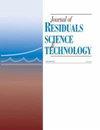煤尘对内蒙古草原5种植物根系生长和光合速率的影响
Journal of Residuals Science & Technology
Pub Date : 2016-01-01
DOI:10.12783/ISSN.1544-8053/13/2/S11
引用次数: 4
摘要
粉尘污染是露天矿的主要环境问题之一,对周边生态系统产生重大影响。关于煤尘沉降对草原植物生长的影响,尤其是对根系生长的影响,目前所知甚少。在本研究中,我们研究了煤尘沉积对植物生长的影响,重点研究了根系的生长。选择内蒙古草原常见的5种植物,采用水培法在温室中栽培。两种煤粉(煤粉和花岗石粉)喷在工厂上35天。测定根系形态参数和光合参数。结果表明,在6个测量的根系形态特征中,大多数树种的根表面积和根体积都受到了煤尘的负面影响。煤矸石粉和煤矸石粉对5种植物中4种的根系生长均有抑制作用。胡枝子是唯一不受粉尘污染影响的树种。煤尘对光合速率有负面影响。根据这些结果,我们发现煤尘对植物生长有害。长期接受煤尘污染的牧草生长可能受到威胁,甚至不能在污染的草地上生长。本文章由计算机程序翻译,如有差异,请以英文原文为准。
Coal Dust Reduce the Rate of Root Growth and Photosynthesis of Five Plant Species in Inner Mongolian Grassland
Dust pollution is one of the major environmental problems in opencast mining, which has a significant impact on the surrounding ecosystem. Little is known about the effect of coal dust deposition on plant growth in grasslands, especially on root growth. In this study, we studied how coal dust deposition affected plant growth, with a focus on root growth. Five plants which commonly can be found in Inner Mongolian grassland were selected and cultured with hydroponics methods in greenhouse. Two kind of coal dust (coal powder and granite powder) were sprayed on the plant for 35 days. Root morphology parameters and photosynthesis parameter were determined. We found that among the six measured root morphological characters, root surface area and volume were negatively affected by coal dust in most species. Both coal powder and gangue powder inhibited root growth of four out of five species. Lespedeza davurica was the only species that was not affected by dust pollution. Coal dust can negativly affect the photosynthesis rate. Based on these results, we found that coal dust is harmful for plant growth. The growth of grass with long-term acceptance of coal dust pollution may be threatened, even can not be grow in the contaminated grassland.
求助全文
通过发布文献求助,成功后即可免费获取论文全文。
去求助
来源期刊

Journal of Residuals Science & Technology
环境科学-工程:环境
自引率
0.00%
发文量
0
审稿时长
>36 weeks
期刊介绍:
The international Journal of Residuals Science & Technology (JRST) is a blind-refereed quarterly devoted to conscientious analysis and commentary regarding significant environmental sciences-oriented research and technical management of residuals in the environment. The journal provides a forum for scientific investigations addressing contamination within environmental media of air, water, soil, and biota and also offers studies exploring source, fate, transport, and ecological effects of environmental contamination.
 求助内容:
求助内容: 应助结果提醒方式:
应助结果提醒方式:


